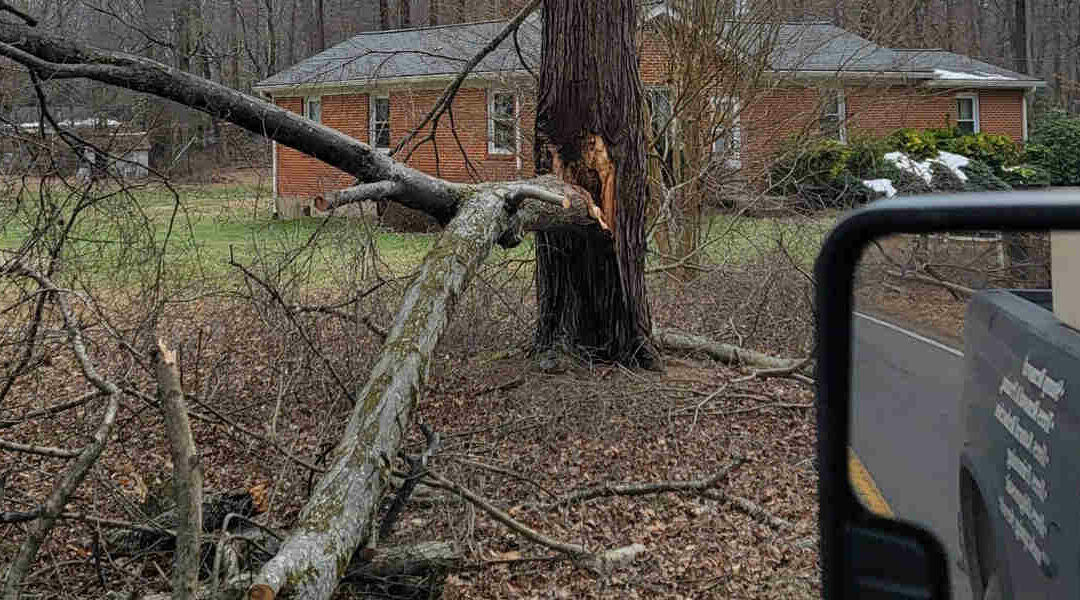If you’ve lived in Maryland long enough, you know how bad the winter storms here get. High-speed winds rip branches off, and heavy snow adds weight that trees can’t always handle. Even trees that appear okay after a storm may secretly have hidden damage that won’t reveal itself for days or weeks.
In this blog post, you’ll learn how to identify storm damage on trees in Bowie, MD, before it becomes a bigger problem. For expert help, call Hernandez Complete Tree Service for reliable tree services in Bowie, MD.
The Crazy Weather Conditions in Bowie, MD
Bowie has seen some serious storms over the last decade. The 2012 derecho tore through our town with winds strong enough to snap trunks and strip trees bare. The 2016 blizzard dropped more than a foot of heavy snow, cracking branches under the weight. Flash floods in 2019 soaked the ground so deeply that root systems gave out and trees tipped over.
Even with all that raw power, the damage these storms leave behind isn’t always easy to spot right away.
Three Signs You’re Dealing With Storm-Damaged Trees
Some signs of tree injury are easy to spot; others are hidden underground or high in the canopy. Look for these common tree hazard indicators before your tree causes an injury or damage to your property.
Sign #1: The Tree Leans or Shifts at the Base
When learning how to identify storm damage on trees, the easiest way to start is by checking for sudden leaning. Raised soil, exposed roots, or a mound forming on the opposite side all indicate that the root system shifted. Leaning trees often fall later with no warning, so make sure you perform a wind damage assessment on any trees you think may have taken damage.
Sign #2: The Trunk Has Deep Cracks or Splits
If you want to catch storm damage before your tree falls and causes injury or property damage, start with the trunk. In Maryland, strong winds and sudden temperature swings twist trunks until they crack under pressure.
These splits usually run vertically and often hide behind bark, so you’ll need to inspect the trunk closely. Once a crack forms, the tree loses structural support and becomes much more likely to fail in the next storm.
Sign #3: The Roots Are Exposed or Damaged
Flooding or shifting soil often pulls back the top layer of earth and leaves roots exposed. Torn or broken roots can’t send water or nutrients through the trunk, which weakens the entire structure.
Root damage usually leads to leaf drop, dead limbs, and reduced growth until the tree finally collapses in a storm. Mushrooms or fungal growth near the base often point to internal rot spreading through the root system. Trees with exposed or damaged roots need a full inspection and often require support or removal.
Post-Storm Tree Care Tips From Hernandez Complete Tree Service
Walk your property and check for storm damage after any kind of major weather event. Leaning trunks, exposed roots, deep splits, or raised soil indicate that the tree has lost stability and could fall during the next storm.
If you’re unsure how to identify storm damage on trees, call Hernandez Complete Tree Service to create a post-storm tree care plan.
Call Hernandez Complete Tree Service for Emergency Tree Care Service
If you think your tree took damage during the last storm, don’t wait to find out the hard way. And if you’re still confused about how to identify storm damage on trees, give Hernandez Complete Tree Service a call at 240-299-4639.
We handle pruning, removal, and support to keep your yard safe. To prevent future damage, read our other blog post on the benefits of tree crown reduction.


